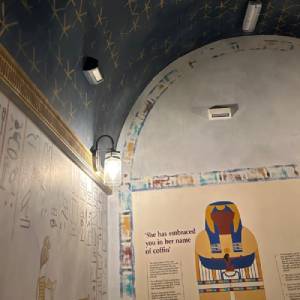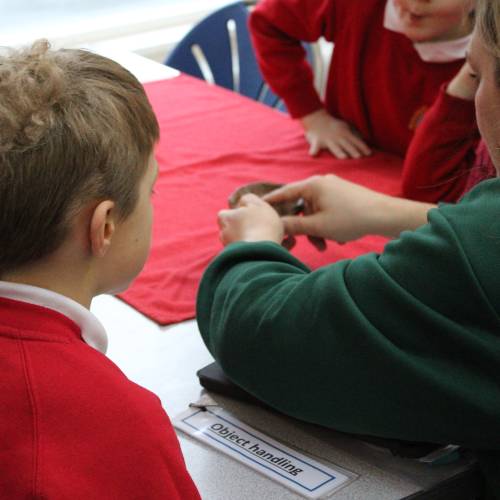A journey through time: Schools explore Ancient Egypt at the Kingdom of Osiris
Ancient Egypt in Kirklees
Have you ever wondered what it might be like to travel back in time? At The Kingdom of Osiris in Bagshaw Museum, visitors can explore our atmospheric tomb, modelled on a real burial chamber at Abydos in Ancient Egypt. Experience the thrill of discovery, just as 20th-century explorers did when they uncovered objects unseen for thousands of years!
While many of us are familiar with male explorers like Howard Carter, who discovered Pharaoh Tutankhamun's tomb in 1922, the stories of their female counterparts are less well-known. You might be surprised to learn that Florence Nightingale, the renowned nurse from the Crimean War, travelled the Nile in 1849 and documented her journey in a book.
Our Egyptian Gallery owes its existence to one such female explorer: Rachel Amelia Lee (née Oldroyd), born in Hanging Heaton, Dewsbury, in 1858. The daughter of local textile business owner George Oldroyd, Rachel's family wealth, accumulated during the Industrial Revolution, enabled her to pursue various personal and public projects. As Secretary for the Egypt Exploration Fund, she raised money for the exploration, surveying, and excavation of Egyptian sites. Interestingly, we have never been able to locate a photograph of Amelia!
In 1892, Rachel travelled to Amarna, Egypt, and sent back numerous artifacts to Dewsbury Museum, including mummy wrappings, tapestries, textiles, and cartonnages. Thanks to her efforts, we can share these treasures with the public today.
As the Museum Learning Officer for Kirklees Museums, my role is to use these stories to inspire school pupils across the region and beyond. Our Egyptian Archaeologist workshop at Bagshaw Museum is one of our most popular school programs, primarily attended by Year 3 and Year 4 pupils. This workshop aligns with the National Curriculum's focus on Ancient Civilizations.
The school visit
During their visit, pupils embark on a treasure-hunt-style trail in the Egyptian gallery. The sight of a real mummified hand often elicits a chorus of "ewww" followed by shouts of "is it real?!" The atmosphere changes dramatically as they enter the replica tomb, walking under a starry sky to inspect the breathtaking coffin lid of Ta-di-ta-nebet-hen, dating back to 680-650 B.C.

Back in the classroom, armed with brushes and trowels, pupils participate in mini archaeological digs. Using sand trays to simulate real-life excavations, they work in groups to uncover objects and make inferences about the type of person they might have belonged to in Ancient Egypt.
A highlight for the pupils is the chance to handle real Ancient Egyptian objects. There is something incredibly special about young hands holding something so ancient-around 5,000 years old! In groups, they discuss what the object might be, who might have used it, and how it was used. This often sparks intriguing conversations about the durability of modern objects compared to those from the past.
The visit concludes with a hands-on mummification activity. Pupils get to take part in a mummification process using our mummification doll-rest assured, no schoolchildren are harmed in this workshop!


A Kirklees curriculum
Innovation and dynamism are crucial to our school programmes. Since starting this role in January, I have been researching ways to develop and improve our offerings. Through a consultation with 139 teachers, we have gained valuable insights that will shape the future of school learning at Kirklees Museums.
The survey responses highlight the significant role local museums can play in supporting school curriculums. As an ex-history teacher of six years, I strongly advocate for integrating local history into curriculums. This approach helps inspire young people and fosters a connection to their past and local communities.
It is also important to reflect on the nature of our collections. The actions of explorers like Amelia would be viewed as looting in contemporary society. Therefore, future developments must facilitate discussions around belonging and collecting.
After extensive research into local school curriculums, and guided by the responses from the teacher consultation, our Cultural Curriculum will provide heritage learning opportunities for all children in Kirklees, from Early Years to Post-16. This will include topics such as nature, the Romans, and life in post 1948 Huddersfield, all of which pupils can learn about through our museums. This is an exciting opportunity for teachers to ensure that local history is woven throughout their curriculum, offering them a chance to engage through online resources, loan boxes or site visits. We are looking forward to launching this in September and working with partner schools to trial our resources.
Visitors can explore the gallery during normal opening hours. Please plan your visit. Find out more information at school visits if you are interested in booking a school visit.
We are always happy to hear from potential volunteers. For more information, please contact ali.bramald@kirklees.gov.uk or apply directly through TSL Kirklees volunteering .

 Written by: Sarah Wilson, Museums Learning Officer
Written by: Sarah Wilson, Museums Learning Officer


